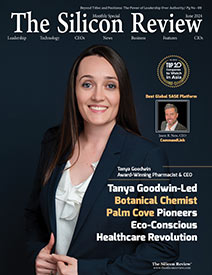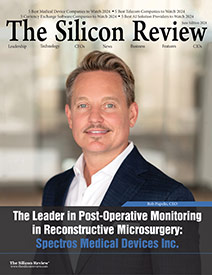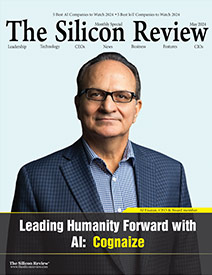An innovator in the field of medical technology, on a mission to globally improve cancer survival rates: CureMetrix
The Silicon Review
![]() In healthcare, images are known to be the largest source of data, as well as the most difficult source to analyze. In recent times, clinicians are majorly dependent on medical image analysis that is often performed by overworked radiologists. This setting will now change because pioneers in the medical technology field are applying AI to image analysis to support the radiologist. Software is being developed based on the latest deep learning algorithms to enable automated analysis for accurate results. When the new automated systems become pervasive enough in the healthcare industry, then the clinicians, radiologists, and even patients can use imaging technology to improve outcomes and monitor treatments.
In healthcare, images are known to be the largest source of data, as well as the most difficult source to analyze. In recent times, clinicians are majorly dependent on medical image analysis that is often performed by overworked radiologists. This setting will now change because pioneers in the medical technology field are applying AI to image analysis to support the radiologist. Software is being developed based on the latest deep learning algorithms to enable automated analysis for accurate results. When the new automated systems become pervasive enough in the healthcare industry, then the clinicians, radiologists, and even patients can use imaging technology to improve outcomes and monitor treatments.
Globally, there are various AI-based imaging solutions but one that stands out from the rest is CureMetrix. The company is a global leader in artificial intelligence (AI) for medical imaging, committed to the advancement of technology that improves cancer survival rates worldwide. CureMetrix supports the radiologist to dramatically improve the accuracy of detection and classification of anomalies in mammography. The company’s mission is to save lives – supporting hospitals, imaging centers, and patients with better clinical and financial outcomes. CureMetrix was founded in 2014, and it is based in La Jolla, California.
In conversation with Navid Alipour Co-founder, CEO and Board Director at CureMetrix
Q. Explain your services in brief.
Currently, CureMetrix specializes in AI-based computer-aided detection (CAD) products for mammography, with the aim of improving breast cancer survival rates by dramatically improving radiologists’ accuracy, detection, and classification of anomalies found in mammograms. We offer radiologists, health care practices, and patients’ peace of mind by delivering CAD that Works®, resulting in faster reading times, fewer unnecessary patient recalls, and improved cancer detection.
Like a second pair of eyes to support the radiologist, our core mammography solutions include:
- cmTriage™: cmTriage is the first—and currently only—FDA-cleared AI-based triage software in the U.S. for mammography. It is a workflow optimization tool that changes the first-in, first-out approach to managing a worklist and enables a radiologist to customize, sort, and prioritize their mammography worklist based on suspicious cases requiring immediate attention. Clinical researchers have found that identifying suspicious cases for radiologists ahead of time reduces their reading time by approximately 30%, freeing their time to focus on the potentially malignant cases that need the most attention—all without sacrificing sensitivity and accuracy of diagnosis.
- cmAssist®: cmAssist is an investigational AI-based SaaS that identifies, marks, and scores regions of interest on screening and diagnostic mammograms. Once a mammogram is flagged as potentially suspicious, cmAssist marks the mammogram, highlighting identified anomalies. It then gives each scan a unique, data-driven neuScore™ that illustrates the level of suspiciousness, which informs the radiologist’s decision whether to recall them for further screening. A study published in the Journal of Digital Imaging found that cmAssist can improve their cancer detection rate by up to 27% without an increase in false-positive recalls. On a related note, using cmAssist can reduce false positives in mammograms by up to 69% when compared to non-AI tools. As with cmTriage, this allows radiologists more time to focus on suspicious cases that are more likely to be positive for breast cancers.
Both cmTriage and cmAssist have been trained on millions of mammogram images from patients worldwide, allowing them to work across all breast densities, lesion sizes, masses, and calcifications. This is important because breast density, or the ratio of fatty tissue to glandular tissue in a woman’s breasts, is an important factor in the accuracy of a typical mammogram reading—and traditional non-AI CAD isn’t sophisticated enough to find small abnormalities in a wide variety of breast densities. Looking for abnormalities in a mammogram is like finding a grain of salt in a sandbox; you’re trying to find something very small against an extremely busy background. AI can learn what to look for in a mammogram image very quickly and learn the infinite number of variables that affect how abnormalities appear (including breast density) and detect subtle differences every time. AI isn’t bound by a human’s limitations (getting tired, failing eyesight), and CureMetrix’s solutions leverage this advantage to support the radiologist and quickly and efficiently find potentially suspicious areas.
Q. Follow-up tests and procedures after an abnormal mammogram can quickly become expensive for women. How does your solution help reduce these costs?
Every time a patient goes into their doctors’ office, whether for an initial mammogram or for follow-up screening and other procedures, it costs them. Using cmTriage to tell right away if a patient’s case is suspicious or not, and then using cmAssist to read their scan if it is marked suspicious, can allow them to leave the office that day knowing whether they need to come in for additional screening, instead of waiting for days or weeks to confirm. This reduces the usual back-and-forth, making for a more efficient process that saves the patient both time and money.
Additionally, the later cancer is found, the more complex the treatment has to be, and the higher the cost for both the healthcare system and the patient. As shown in the diagram below, a patient’s’ chances of surviving breast cancer decrease significantly the later the stage in which it’s diagnosed. CureMetrix AI helps radiologists catch more cancers earlier, giving patients a higher chance of beating the disease and avoiding expensive, complicated treatments with lower chances of success.
Q. How has CureMetrix technology been tested?
CureMetrix AI has been extensively tested since its development over five years ago, and researchers have found that it works in both the lab and in a real-world clinical setting. We have collected over millions of mammogram images to train our AI products, improving our algorithm for use across age groups, ethnicities, and breast densities. We were able to gather this many images through collaboration and research with esteemed institutions, including MD Anderson Cancer Center, Johns Hopkins University Medical Center, University of California, San Diego, DASA, and many others.
A recent study analyzed three months in the life of a U.S. academic radiology practice in order to observe how the clinic performed without the support of AI —and see how they could have performed if they had used the CureMetrix AI-based CAD. cmTriage and cmAssist correctly identified 100% of the cancers that the practice had identified without the assistance of AI, and CureMetrix also identified an additional three cancers that were initially missed by the radiologists but diagnosed in later exams—cancers that could have been detected in earlier stages, improving a patients’ survival chances and simplifying the required treatment.
Q. Are you launching any new services beyond cmTriage and cmAssist?
CureMetrix is continually conducting studies across the globe to expand its AI solutions that help identify, mark, and score anomalies in breast cancer screening, and make sure its existing solutions are performing optimally. Right now, we’re working to submit cmAssist for FDA clearance in the coming months. We also have a robust product pipeline in place that includes expansion into Europe, as well as product extension that includes reporting solutions for radiology.
In addition to cmTriage and cmAssist, we’re very excited about cmAngio™, our investigational triage software that determines a patient’s risk of coronary heart disease (CHD) based on her mammogram scan. cmAngio looks for breast arterial calcifications’ existence and characteristics and then assigns a score based on how suspicious any anomalies are. This proprietary score can then be used to help a doctor determine the patient’s risk for CHD so that she can be referred to a cardiologist for an appropriate course of treatment or preventative measures.
I truly believe in the power of AI to improve upon medical professional’s expertise. Pretty soon, I think AI will be like microscopes—an indispensable tool you’ll find in every medical setting.
For more information visit:
Meet the leader behind the success of CureMetrix
Navid Alipour is Co-founder, CEO and Board Director at CureMetrix, a global leader in artificial intelligence (AI) for medical imaging. He helped launch CureMetrix and other companies through his role as Co-founder and Managing Partner at Analytics Ventures, a global venture studio focused on AI and machine-learning based healthcare solutions.









